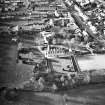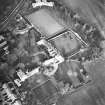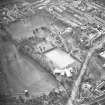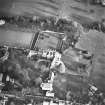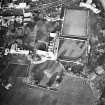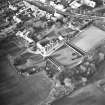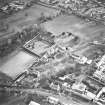Musselburgh, High Street, Pinkie House, Garden
Garden (17th Century), Midden (Roman) - (19th Century), Sundial(S) (17th Century), Pot (Medieval)
Site Name Musselburgh, High Street, Pinkie House, Garden
Classification Garden (17th Century), Midden (Roman) - (19th Century), Sundial(S) (17th Century), Pot (Medieval)
Alternative Name(s) Loretto School; Pinkie House Policies
Canmore ID 120735
Site Number NT37SW 4.02
NGR NT 34944 72676
NGR Description Centred NT 34944 72676
Datum OSGB36 - NGR
Permalink http://canmore.org.uk/site/120735
- Council East Lothian
- Parish Inveresk (East Lothian)
- Former Region Lothian
- Former District East Lothian
- Former County Midlothian
NT37SW 4.02 centred on 34944 72676
See also NT37SW 106.16 for the sundial in the grounds of Loretto School north of Linkfield Road.
Field Visit (11 October 1920)
GARDENS, SUNDIALS, ETC.
North and east of the house lie the gardens enclosed by massive walls with moulded copings; in these walls are doorways of Renaissance design. Two bear initials A E. D. 5.7 (Alexander Earl of Dunfermline [ætat.] 57) and M. C. D. (Margaret Countess of Dunfermline [ætat.] 21). The conservatory obscures another doorway opening to the policy; this doorway has a good moulded architrave and is surmounted by a strap-worked cartouche flanked by engaged shafts. In 1884 two slabs, which had long been lying detached and exposed to the weather, were built into the wall through which it passes, one on either side of the doorway.
The panel on the north side bears a coronet with the initials A. S. and M. H. in monogram. The stone is much weathered and some of the letters are partially or wholly illegible. There is no doubt, however, as to the original reading:*
D. O. M.
SIBI . POSTERIS . BONIS . OMNIBVS . HVMANIS . VRBANISQVE . / HOMINIBVS . VRBANITATIS . OMNIS . HVMANITATISQVE . / AMANTISSIMVS . ALEXANDER . SETONIVS . VILLAM . / HORTOS . ET . HÆC . SVBVRBANA . ÆDFICIA· FVNDAVIT . / EXSTRVXIT . ORNAVIT . NIHIL . HIC . HOSTILE . NE . ARCENDIS / . QVIDEM . HOSTIBVS . NON . FOSSA . NON . VALLVM .VERVM . / AD . HOSPITES . BENIGNE . EXCIPIENDOS . BENEVOLE . / TRACTANDOS . FONS . AQVÆ . VIRGINIS . VIRIDARIA . /PISCINÆ · AVIARIA . PER . AMŒNITATEM . OMNIAAD. CORPVS . / ANIMVMQVE . HONESTE . OBLECTANDVM . COMPOSVIT . / QVISQVIS . IGITVR . IN . HÆC . FVRTO . FERRO . FLAMMA . / SEV . QVOMODOLIBET . HOSTILITER . SE . GESSERIT . / IS . SE . OMNIS . CARITATIS-VRBANITATISQVE . / EXPERTEM . IMMO . HVMANITATIS . OMNIS . HVMANIQVE . / GENERIS . HOSTEM . PROFITEATVR . LAPIDES . SANCTI . / LOQVENTVR . ET . PROMVLGABVNT.
[‘TO GOD MOST HOLY AND MOST HIGH For his own benefit, for the benefit of his descendants, and for the benefit of all good, humane and cultured men, Alexander Seton, a devout lover of all culture and humanity, founded, erected and adorned his country-seat, the gardens and these suburban buildings. Here there is nothing that savours of enmity, not even for defence against enemies; no ditch, no rampart; but for the gracious welcome and hospitable entertainment of guests a fountain of pure water, lawns, ponds and aviaries. In ways of pleasantness he has laid out all these for the honourable delight of body and of soul. Whoso therefore shall have comported himself towards them with enmity whether by robbery, sword, fire or in any way whatsoever, let that man proclaim himself devoid of charity and culture, nay rather an enemy of all humanity and of the human race. The stones of dedication ** will find full voice and publish it abroad."]
The south panel bears beneath a coronet the initials A. S. E. D. in monogram and the inscription:
[DEO] [O]PTIMO MAXIMO I [RE]RVM [OMNIVM] AVTHOR[I] / LARGITORI CONSERVATORI / IEHOVAE STATORI I CVIVS NVTV BENEFICIO / STANT BONA OMNIA C[ERTA] / HONOR OMNIS GLOR[IA]:
"To God most holy and most high, the author, the giver, the preserver of all things, Jehovah who is my strength, by whose will and loving kindness all blessings are assured, all honour and glory." Then follow, in Greek capitals, the words "Eulogia kai Eucharistia" ("Praise and thankfulness").
SUNDIALS.
(1) A plain tabular dial on the oriel, which probably dates from the 17th century.
(2) An obelisk dial set on the north wall of the garden east of the house, canted and not parallel to the wall line. The dial-stone is cubical and contains four incised dials. The pedestal beneath has been plated or perhaps painted with other dials; above the dial-stone rises a finial resembling those of the entrance gates and the well-head.
(3) The cap-stone of a 17th-century sundial, octagonal on plan, measuring 16 ¼ inches in diameter and 5 ½ inches in thickness. There is a dial on the upper surface and one on each of the facets.
RCAHMS 1929, visited 11 October 1920.
*The version printed in The Book of Seton (p. 822) is unfortunately both incomplete and inaccurate.
**The allusion is to the stone bearing this inscription and its fellow, both of them being dedicated to ‘God most holy and high’.
Excavation (7 July 2020 - 10 July 2020)
NT 34942 72677 A programme of recording and excavation of a series of trenches within the grounds of Pinkie House, Musselburgh, was undertaken in July 2020. Pinkie House is a Category A listed building and the walled garden is listed separately as Category B. Both are within the boundary of the Inventory Garden and designed landscape of Pinkie House. A series of trenches had previously been excavated within and to the N of the walled garden in order to supply services to temporary accommodation units. The sides and base of the trenches were cleaned and recorded and any features present were sample excavated within the confines of the trenches. The spoil was inspected, artefacts were collected and their location recorded. Historic maps and documents were consulted in order to provide information on the early layout of the walled garden.
Within the walled garden Trenches 1–4 showed that the upper 0.7m of ground had been disturbed by more recent landscaping and drainage work. At the base of Trenches 1 and 2 the remains of a central path associated with a formal garden survived. Beneath this, two linear features were excavated, which may be earlier garden features or indeed pre-date the construction of the formal gardens; no dating evidence was recovered. As Trenches 1–4 had been excavated through disturbed subsoil they had not impacted on the remains of the early garden.
Trench 5 to the N of the walled garden contained a large spread of midden material within a cut. The artefacts ranged in date from a single sherd of Roman pottery to 19th-century ceramics. The finds were evenly distributed with no concentrations in evidence. The wide date range and distribution would appear to indicate a deliberate dumping of imported material rather than an accumulation of rubbish from adjacent settlement.
In September 2020 additional excavations to provide drainage, footings for the temporary cabins, and a small area of hard standing to accommodate water tanks were monitored. Five sherds of pottery including one sherd of green glaze were found. Two brick, stone and concrete piers were uncovered. They did not appear to be in their original position but may have been bases for relatively modern garden features.
Archive: NRHE (intended)
Funder: Loretto School
Jenni Morrison − Addyman Archaeology
(Source: DES Vol 21)
OASIS ID: addymana1-402163



























